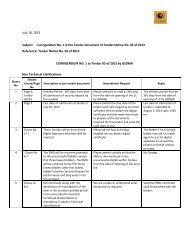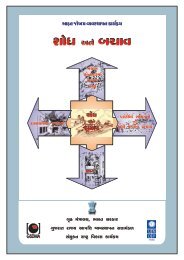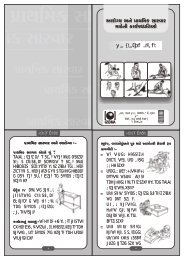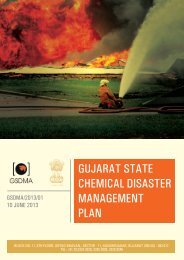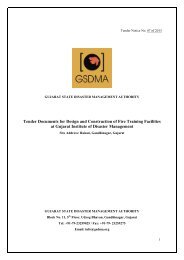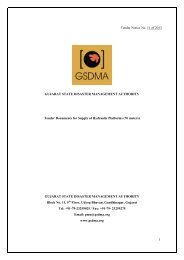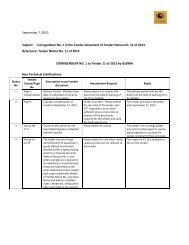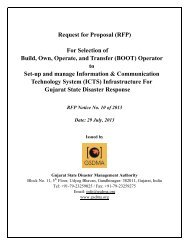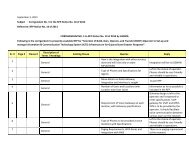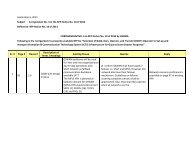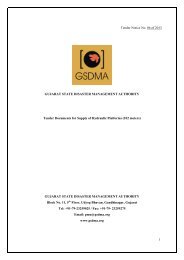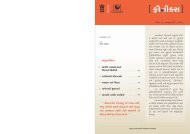Emergency Response Guidebook - Gujarat State Disaster ...
Emergency Response Guidebook - Gujarat State Disaster ...
Emergency Response Guidebook - Gujarat State Disaster ...
You also want an ePaper? Increase the reach of your titles
YUMPU automatically turns print PDFs into web optimized ePapers that Google loves.
GUIDE120Gases - Inert(Including Refrigerated Liquids)ERG2012ERG2012Gases - Inert(Including Refrigerated Liquids)GUIDE120POTENTIAL HAZARDSHEALTH• Vapours may cause dizziness or asphyxiation without warning.• Vapours from liquefied gas are initially heavier than air and spread along ground.• Contact with gas or liquefied gas may cause burns, severe injury and/or frostbite.FIRE OR EXPLOSION• Non-flammable gases.• Containers may explode when heated.• Ruptured cylinders may rocket.PUBLIC SAFETY• CALL EMERGENCY RESPONSE Telephone Number on Shipping Paper first. If Shipping Paper notavailable or no answer, refer to appropriate telephone number listed on the inside back cover.• As an immediate precautionary measure, isolate spill or leak area for at least 100 meters (330 feet) inall directions.• Keep unauthorized personnel away.• Stay upwind.• Many gases are heavier than air and will spread along ground and collect in low or confined areas(sewers, basements, tanks).• Keep out of low areas.• Ventilate closed spaces before entering.PROTECTIVE CLOTHING• Wear positive pressure self-contained breathing apparatus (SCBA).• Structural firefighters’ protective clothing will only provide limited protection.• Always wear thermal protective clothing when handling refrigerated/cryogenic liquids or solids.EVACUATIONLarge Spill• Consider initial downwind evacuation for at least 100 meters (330 feet).Fire• If tank, rail car or tank truck is involved in a fire, ISOLATE for 800 meters (1/2 mile) in all directions;also, consider initial evacuation for 800 meters (1/2 mile) in all directions.EMERGENCY RESPONSEFIRE• Use extinguishing agent suitable for type of surrounding fire.• Move containers from fire area if you can do it without risk.• Damaged cylinders should be handled only by specialists.Fire involving Tanks• Fight fire from maximum distance or use unmanned hose holders or monitor nozzles.• Cool containers with flooding quantities of water until well after fire is out.• Do not direct water at source of leak or safety devices; icing may occur.• Withdraw immediately in case of rising sound from venting safety devices or discoloration of tank.• ALWAYS stay away from tanks engulfed in fire.SPILL OR LEAK• Do not touch or walk through spilled material.• Stop leak if you can do it without risk.• Use water spray to reduce Vapours or divert Vapour cloud drift. Avoid allowing water runoff tocontact spilled material.• Do not direct water at spill or source of leak.• If possible, turn leaking containers so that gas escapes rather than liquid.• Prevent entry into waterways, sewers, basements or confined areas.• Allow substance to eVapourate.• Ventilate the area.CAUTION: When in contact with refrigerated/cryogenic liquids, many materials become brittle and arelikely to break without warning.FIRST AID• Move victim to fresh air.• Call 108 or emergency medical service.• Give artificial respiration if victim is not breathing.• Administer oxygen if breathing is difficult.• Clothing frozen to the skin should be thawed before being removed.• In case of contact with liquefied gas, thaw frosted parts with lukewarm water.• Keep victim warm and quiet.• Ensure that medical personnel are aware of the material(s) involved and take precautions to protectthemselves.Page 180Page 181



